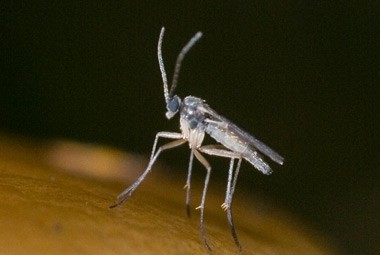
Dark winged fungus gnats are a species of nuisance fungus gnat. Their larvae feed on the fungi that are found in extremely moist or overwatered soil. They are very common in potted plant soil, especially if it has a high content of organic matter in it.
| Pest Identification | |
|---|---|
| Recognition | Dark winged fungus gnats are grayish-black in color and have smoky colored wings. They have a slender body with longs legs and long antennae. Adults grow only to be about 1/8th of an inch in length. Their eggs are very small and whitish-yellow in color. The larvae are slightly larger than the adults at about ¼ of an inch in length. They have a white body and black head. The pupae start out white in color but right before the adult emerges they darken in color. |
| Biology | Dark winged gnats have a short life cycle. Adults live for about 1 week and during that time each female lays about 100-150 eggs. She lays her individual eggs in the soil where the larvae hatch in about 3-4 days. The larvae then begin feeding on any organic matter in the soil or on the roots of plants, causing the plants to wilt and die in cases of heavy infestations. After about 8-14 days the now mature larvae pupate and adults surface in approximately 3 days already to start the life cycle over once again. |
| Habits | Dark winged fungus gnats are most problematic in greenhouses and for mushroom growers. In homes and other buildings they can be found in and around damp woodwork, damp drywall, and leaky roofs. Outside they can be found in wet decaying mulch, compost piles, and older firewood piles. During the day adults will rest in dark moist places coming out during the early morning and evening hours. Adults can be seen gathering around windows, doors, and lamps as they are attracted to light. |
| Prevention | The best way to prevent problems with dark winged fungus gnats is to fix the areas on your property that may be attracting them to it. Get rid of old piles of wood, make sure to remove older mulch before placing new on top of it, and remove piles of leaves or other organic debris. You should use sprinklers on your lawn sparingly and make sure not to over-water potted houseplants. If any woodwork or drywall in your home has been damaged by water remove and replace it. If you have an infestation indoors, re-potting plants can help to eliminate breeding areas. Reducing moisture levels in your home through the use of dehumidifiers and air-conditioners can also help to prevent problems with dark winged fungus gnats. |
| Professional | Here at Rottler Pest & Lawn Solutions, we will inspect your home to identify conditions that can be conducive to fungus gnat breeding. We will make recommendations for controlling moisture and any necessary treatments to help eliminate infestations. |

